Respiratory System for Kids
The respiratory system worksheet is from the
MatchCard Science Human Anatomy Unit Study for grades 3 - 8.
Free Download Below
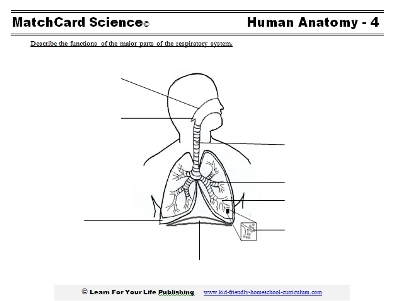
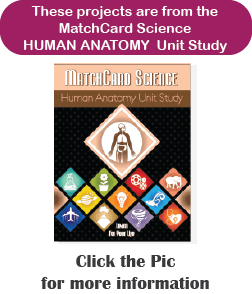
The Respiratory System
Objective: Describe the functions of the major parts of the respiratory system.The MatchCard Information Pieces on the download below will identify the following:
- trachea
- bronchus
- bronchiole
- alveoli
- pharynx
- epiglottis
- pleural space
- diaphragm muscle
Download the Respiratory System MatchCard
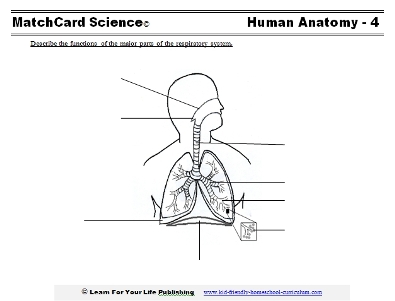

This is MatchCard #4 of the Human Anatomy Unit Study.
Click the image above to print.
More Information Below on MatchCard Science and the Human Anatomy Unit Study.
Projects for the Respiratory System for Kids
Does the air you breath have weight?
Respiratory System Project #1
Ask the students if they think they weigh more when they have inhaled than when they exhaled. Give them a chance to think about it. Ask them to develop a scientific experiment to determine the answer.If you have a balance scale, this is an easy experiment to do. Otherwise, you will need a scale that weighs in grams (like a postage meter scale.)
You will also need two balloons that are the same size.
With the balance scale, tie the two balloons to opposite ends with two pieces of string or thread that are the same size. Balance the scale.
Now blow one balloon up. Put it back on the scale. Students will quickly see that the blown up balloon weighs more.
Air has both volume and weight.
How much do you exhale?
Respiratory System Project #2
Here is another project on the respiratory system for kids. How much air do you exhale in a typical breath.Have the kids focus on their breathing. Think about the amount of air in the balloon. Is that the amount you have in a typical breath?
To find out, you will need a small plastic bag without holes. A small bathroom sized bathroom trash bag would work. (The plastic bags from the grocery store would be a sufficient size, but they usually have holes and would not work.)
A larger bag can also be used, but it is more clumsy and gives more room for error.
Hold the bag bunched up around your fist as if it was a balloon. Exhale your normal amount into the bag. Since the bag is a little larger, you will have to push the air into one end (like cake decorators do with bags of frosting.)
Can you guess how much that is?
While one person continues to hold the air in one bag, have another person add water to an identical bag. Try to fill it the same amount.
Carefully pour the water into a measuring container. Was your guess close?
Total Lung Capacity
Respiratory System for Kids Project #3
In the last experiment, you estimated the volume of your normal breath. Another word for normal breath is "tidal volume." But what is the maximum amount of air you can exhale?Lung capacity is the term we use to describe the amount of air the lungs can hold.
Take a regular breath and let it out. Now put the bag in front of your mouth to breathe into. Before you inhale, exhale more, more and even more. Let out all the air you possibly can. That air is your expirtory reserve capacity. It is a reserve of air that is inside your lung, but that normally is not exhaled.
You also have an inspiratory reserve volume. How much is that? After taking five or six normal breaths, take a deep, deep breath in. Fill your lungs as far as you can. That is your inspiratory reserve volume.
Can you think of what the inspiratory and expiratory reserve volume are for?
If you can't imagine what the reserve volume of your lungs is for, run around your house as fast as you can two times. Then come in and think why you might need a reserve volume.
Emphysema is a lung disease caused by smoking where the lungs loose their flexibility and their reserve volume. People with emphysema may not be able to take bigger breaths. That prevents them from running or even walking very far.
Okay, give your lungs a chance to come back to their normal breathing volume. Then we will try one more lung volume and see if you can measure it.
Take in a deep, deep breath filling your lungs all the way. Quickly bring the trash bag to your mouth and exhale all of that air, all of your regular air, and all of your expiratory reserve volume. Keep exhaling until you can't possible exhale anymore.
Wow! That was a lot of air. Did you need a larger trash bag to catch it all? Congratulations! You are holding your vital capacity in your bag.
You may have noticed that even after you have exhaled everything you possible can, there is still a little more air left in your lungs. That is your residual volume. Sorry, we just can't measure that.
You may want to make a poster showing the terms you have just learned. Here is a phrase you will want to show: VC = TV + IRV + ERV
And if we could measure that reserve volume we would get total lung capacity. That is TLC = VC + RV
Compare lung sounds with stethoscope
Respiratory System for Kids Project #5
Inexpensive stethoscopes can be acquired at local pharmacies. By putting the bell of the stethoscope over different lung fields, different sounds are heard.Compare the sounds of the trachea, main bronchi close to the sternum, and over the smaller bronchioles.
Heart and Lungs Together
So what happens to that oxygen once you breathe it in? If it weren't for the heart, it would stay right in your lungs.Learn about the heart and lungs work together in the circulatory system.
Worksheet on the Respiratory System For Kids
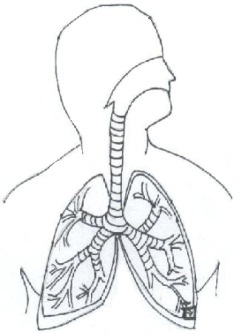
Pharynx
That is the anatomical word for the back of your throat. Take a breath in with your mouth open. You will feel cool air on the pharnyx.Epiglottis
The epiglottis is a fold of tissue that opens and clothes the trachea (or windpipe.) You don't want food to go into your lungs or air to go into your stomach. It is the job of the epiglottis to close the trachea when you swallow.
Trachea
Take a noisy, gasping breath. You are listening to air go in and out of the trachea. It goes down your neck, next to the esophagus which takes food to the stomach.
Bronchus
A bronchus is a large tube that branches from the trachea to the lobes of the lungs. The plural of bronchus is bronchi.
Bronchiole
Look at a picture of a branching tree. Major limbs become smaller limbs, which become branches and trees. In the same way the bronchi branch into smaller bronchioles.
By the way, have you ever heard of bronchitis. "Itis" means inflammation (often from an infection.) So bronchitis is an infection that is in the bronchi and bronchioles.
Alveoli
Just as leaves are at the end of a twig, alveoli are little air sacs at the end of the smallest bronchioles. You can imagine them as clusters of grapes - only they are very, very tiny.
A small portion of the air you breath goes into the alveoli. Then the oxygen in that air is transported across a membrane and into your blood stream. At the same time, carbon dioxide is transported across the membrane and into the alveoli.
When you exhale, the carbon dioxide and all the other molecules in the air are released into the atmosphere.
Bronchus
A bronchus is a large tube that branches from the trachea to the lobes of the lungs. The plural of bronchus is bronchi.
Bronchiole
Look at a picture of a branching tree. Major limbs become smaller limbs, which become branches and trees. In the same way the bronchi branch into smaller bronchioles.
By the way, have you ever heard of bronchitis. "Itis" means inflammation (often from an infection.) So bronchitis is an infection that is in the bronchi and bronchioles.
Alveoli
Just as leaves are at the end of a twig, alveoli are little air sacs at the end of the smallest bronchioles. You can imagine them as clusters of grapes - only they are very, very tiny.
A small portion of the air you breath goes into the alveoli. Then the oxygen in that air is transported across a membrane and into your blood stream. At the same time, carbon dioxide is transported across the membrane and into the alveoli.
When you exhale, the carbon dioxide and all the other molecules in the air are released into the atmosphere.
By the way, have you ever heard of bronchitis. "Itis" means inflammation (often from an infection.) So bronchitis is an infection that is in the bronchi and bronchioles.
Alveoli
Just as leaves are at the end of a twig, alveoli are little air sacs at the end of the smallest bronchioles. You can imagine them as clusters of grapes - only they are very, very tiny.
A small portion of the air you breath goes into the alveoli. Then the oxygen in that air is transported across a membrane and into your blood stream. At the same time, carbon dioxide is transported across the membrane and into the alveoli.
When you exhale, the carbon dioxide and all the other molecules in the air are released into the atmosphere.
MatchCard Science
How To Use MatchCards

Download the FREE MatchCard Science Instructor's Guide and see how MatchCards can make building their science knowledge base fun.
Human Anatomy Unit Study
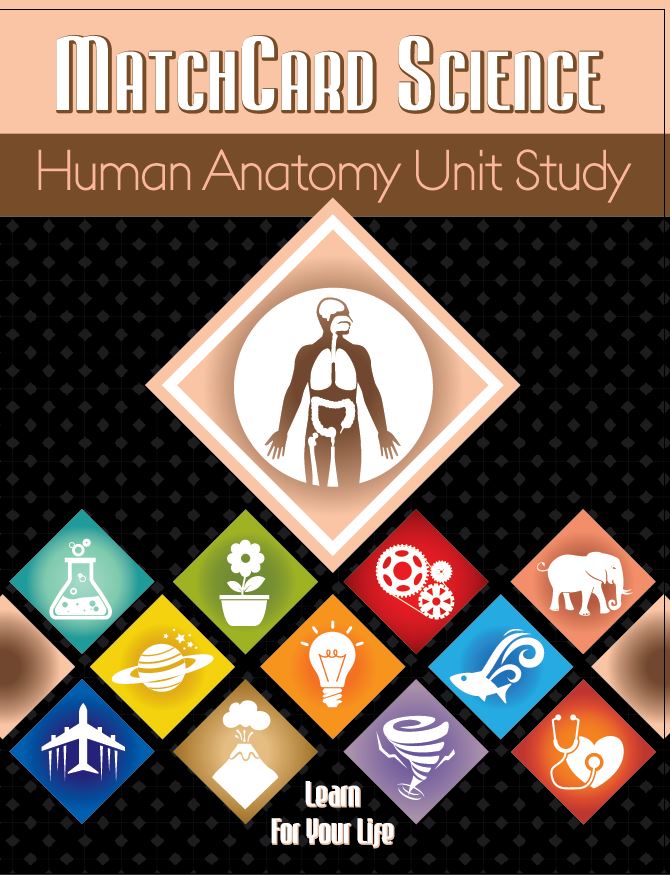
Download the entire Human Anatomy Unit Study
12 Science Unit Studies

Chemistry is only one of twelve complete unit studies for kids in 3rd to 8th grade.
Comprehensive objectives, hands-on projects, suggested science fair experiments, and the fun game-like MatchCards keep them interested in learning science. See all twelve MatchCard Science Unit Studies.
About Our Site
Hands-On Learning













